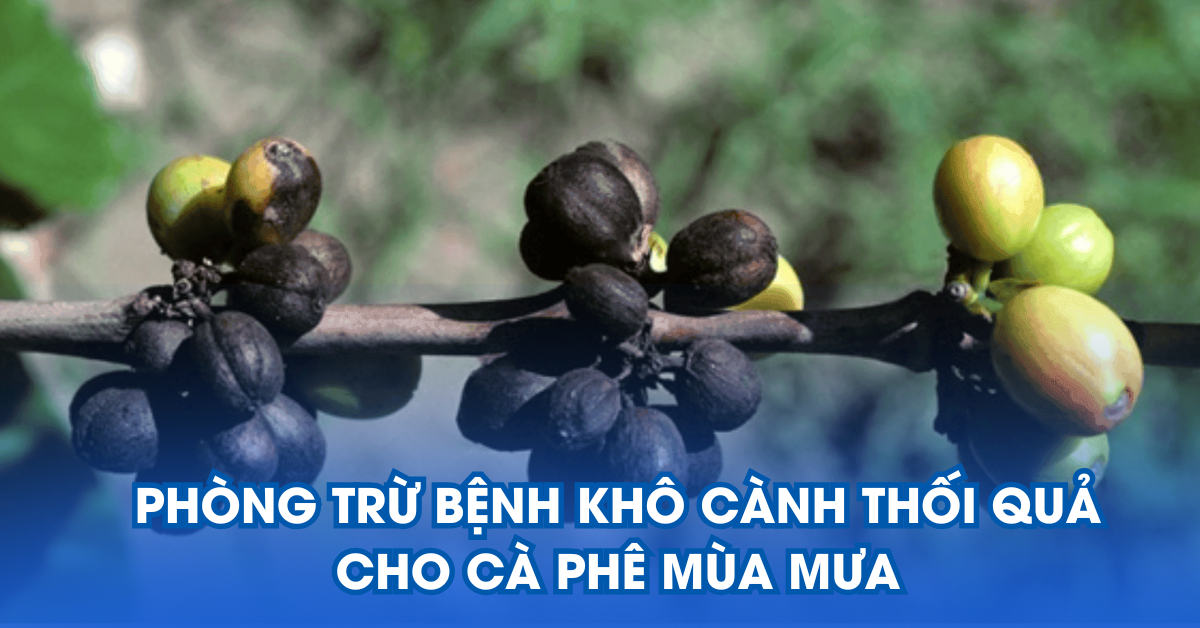Preventing Dry Branches And Fruit Rot In Coffee In The Rainy Season
29 May 2025

How to effectively prevent dry branches and fruit rot in coffee trees in the rainy season, helping farmers maintain productivity and prevent fungi from developing in humid conditions.
Comprehensive solutions to prevent dry branches and fruit rot in coffee trees in the rainy season
The rainy season is the period when coffee trees grow strongly but it is also the time when diseases break out, especially dry branches and fruit rot. High humidity and heavy rain make the garden always wet: ideal conditions for fungi to develop rapidly.
These two diseases not only affect the health of the tree but also significantly reduce the yield and quality of the fruit. Therefore, correctly identifying the symptoms, understanding the causes and applying timely prevention and treatment measures are key factors for farmers to effectively protect their coffee gardens in the rainy season.
Dry branches - signs and damage mechanisms
The phenomenon of dry branches often starts with small signs such as yellow leaves falling from the outside in. Young branches can dry from the top down, with cracks or dark spots on the bark. If not treated promptly, the entire branch can dry up, affecting the tree's ability to grow fruit.
Coffee trees have dry branches, yellow leaves fall off and branches dry from the top. Photo: internet
The main cause comes from the fungi Colletotrichum spp. and Fusarium spp., attacking through mechanical wounds or caused by insects. The dense tree density and dense foliage make the garden not airy, creating favorable conditions for fungi to thrive in the rainy season.
Fruit rot - a direct threat to crop yield
Fruit rot often appears clearly after prolonged rains. Coffee fruits turn black, become soft and mushy, and fall off easily. Young fruits are more susceptible to disease due to thin skin and weak resistance. During the stage of rapid fruit growth, fungi such as Phytophthora spp. or Anthracnose easily penetrate through small scratches, including those caused by insects or collisions during harvesting and pruning.
If there is no early treatment, the fungus will spread, causing massive fruit rot, severely affecting the yield and quality of green coffee
Coffee berries rot black, become soft, and fall off easily after rain. Photo: internet
Disease prevention measures using cultivation techniques
To minimize the disease of dry branches and fruit rot, the first measure is to create an airy garden environment. Farmers should regularly prune branches to create a canopy so that light can easily penetrate, helping the tree dry quickly after rain. This not only prevents fungus but also improves the efficiency of photosynthesis for the tree.
Thorough garden sanitation is also an important factor. Plant residues such as fallen leaves and diseased fruit need to be collected and destroyed properly. Weeds should be cleared regularly to limit the habitat of pests and diseases.
Balanced nutrition plays a role in increasing the resistance of the tree. Avoid fertilizing with too much nitrogen because the plant will grow weak young shoots and be susceptible to disease. Instead, you should add potassium, calcium and trace elements. Some effective fertilizer products for the rainy season include:
- Organic microbial fertilizers: ANIMA, ORGANICONCO - improve soil and increase resistance.
- NPK specifically for the rainy season: NPK CON CO 16-16-8+13S+Zn+B, NPK CON CO 19-16-8+TE...
Fertilization dosage is from 300-500g/tree, adjusted depending on the age of the tree, the yield of the previous crop and the soil conditions.
Use pesticides appropriately during the rainy season
In addition to care measures, farmers need to proactively spray fungicides at the beginning of the rainy season, when humidity begins to increase. Spraying periodically every 20-30 days will help prevent fungi from developing and spreading.
Some common fungicides include:
- CO-TRIHEX: effective against fungi that cause dry branches.
- MYFATOP 325 SC, NEWCOZEB, SUPER KOSTIN: specialized in treating fruit rot fungi.
- COFOLI PK500: increased effectiveness when combined with fungicides.
When spraying, it is necessary to rotate active ingredients to avoid drug resistance. Prioritize spraying in the early morning when the sun is mild, focusing on the underside of leaves and areas with thick tree canopy.
In particular, farmers should check and dig good drainage ditches to avoid long-term waterlogging that causes fungi to develop rapidly.
Conclusion:
Prevention of dry branches and fruit rot cannot be done carelessly. It requires a combination of scientific cultivation, proper care and proactive use of pesticides. When the trees are healthy, the soil is clean, and the garden is airy, the rainy season is no longer a threat, but will become an advantage to help coffee grow strongly.
Views
651
